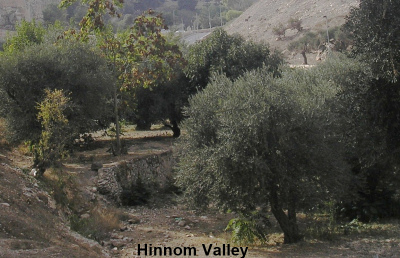The Greek word from which we get the (mistranslated) English word "hell" in the KJV version of Matthew 5:22 is Gehenna (Strong's Concordance #G1067). This word means "valley of Hinnom" according to Strong's and Thayer's Greek Definitions. There are also other New Testament locations where the King James erroneously uses this word instead of a direct reference to the valley (Matthew 5:29, 30, 10:28, 18:9, 23:15, 33, Mark 9:43, 45, 47, Luke 12:5).
The first two places where "hell" (the Hinnom Valley) occurs in Scripture are as the boundary between the land inherited by the tribes of Benjamin and Judah (Joshua 15:8, 18:16).
A gruesome history
Anciently, the Hinnom valley was one of the places where the idolatrous Israelites worshipped the pagan gods Moloch (Molech) and Baal using, among other things, fire (the fire of Gehenna). Many of the kings of Judah and Israel personally endorsed such worship.

Amazingly, Judah's King Ahaz (whose rule began in 735 B.C.) not only made idols, he sacrificed his own sons in the valley by having them burned and offered as a pagan burnt offering (2Chronicles 28:1 - 3)!
One of the national reforms of King Josiah was to destroy all the places used to worship false gods. He stopped this practice near Jerusalem, when he "defiled Topheth, in the valley of the children of Hinnom, so that no man might make his son or his daughter to pass through the fire to Molech" (2Kings 23:10, HBFV).
According to Adam Clarke's Commentary, the word topheth means drum. It is a reference to the drums used to drown out screaming children as they were placed, alive, on the red-hot arms of a pagan god as a sacrifice!
Although pagan sacrifices were not being made at Hinnom during the time of Jesus, many fires still burned in the valley. According to Albert Barnes' Notes, the location was commonly used as a city dump, a place where the trash of the city and dead carcasses were thrown, and where even public executions took place. Fires were constantly burning in the area (Gehenna fire) so that they could completely consume the continuous stream of garbage thrown into it.
Symbolic meaning
Jesus used the constantly burning fires of Hinnom to symbolize the complete and eternal punishment (not punishing) awaiting those who refuse to repent of hatred and anger. Those who willingly and willfully refuse to obey God will receive the ultimate death penalty (known as the second death) where their existence is erased and from which there is no resurrection.